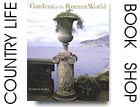Book Review: Gardens of the Roman World
Kathryn Bradley-Hole savours an account of horticultural endeavor 2,000 years ago


Gardens of the Roman World, by Patrick Bowe (Frances Lincoln, £24.50)
From the wealth of preserved frescoes and mosaics, we see that gardens in the Roman world were full of birds ? swallows, doves, wood pigeons, magpies, jays, thrushes, nightingales, warblers; also peacocks, herons, Egyptian ibis, partridges and orioles. While these are usually depicted as ranging freely about the gardens, aviaries were also popular.
The epicure Lucullus even set out a dining area within his aviary so that 'his guests could have the curious enjoyment of eating cooked fowl while being surrounded by their still-alive 'cousins''. Patrick Bowe's lavishly illustrated new book draws together a range of captivating images and text sources to give us as thorough an overview as possible into Roman horticultural and landscaping endeavours which have had a lasting influence in the succeeding 2,000 years.
Then there were the plants: the crucial evergreens ? cypress and plane trees, myrtle, bay, laurustinus, strawberry trees (Arbutus unedo), box and ivy ? plus vines, pomegranates, roses, lilies, chamomile and pinks. Excavation of Pompeii and Herculaneum provided scores of examples of town gardening Roman-style, with the emphasis on symmetry; peristyle enclosures, pools and marble fountains, so essential for providing a cooling atmosphere in the heat of a Mediterranean summer. This lovely book explores the rich variety of gardens made throughout the extent of Rome's empire.
Sign up for the Country Life Newsletter
Exquisite houses, the beauty of Nature, and how to get the most from your life, straight to your inbox.
Country Life is unlike any other magazine: the only glossy weekly on the newsstand and the only magazine that has been guest-edited by HRH The King not once, but twice. It is a celebration of modern rural life and all its diverse joys and pleasures — that was first published in Queen Victoria's Diamond Jubilee year. Our eclectic mixture of witty and informative content — from the most up-to-date property news and commentary and a coveted glimpse inside some of the UK's best houses and gardens, to gardening, the arts and interior design, written by experts in their field — still cannot be found in print or online, anywhere else.
-
 Six rural properties with space, charm and endless views, as seen in Country Life
Six rural properties with space, charm and endless views, as seen in Country LifeWe take a look at some of the best houses to come to the market via Country Life in the past week.
By Toby Keel
-
 Exploring the countryside is essential for our wellbeing, but Right to Roam is going backwards
Exploring the countryside is essential for our wellbeing, but Right to Roam is going backwardsCampaigners in England often point to Scotland as an example of how brilliantly Right to Roam works, but it's not all it's cracked up to be, says Patrick Galbraith.
By Patrick Galbraith